2016 Lawn thread
Discussion
sider said:
What are the key dates within a year for treating a lawn?
Autumn is the best time for major lawn renovations, but spring is a very close second. sider said:
Our front lawn is pretty much in the shade of the house all day and tends to be quite bouncy with moss, whereas the back grows quickly but can be patchy depending on where the dog pees!
Once the moss on the front lawn is dealt with, overseed with a blend that's happy in the shade and cut on the high side. Moss is opportunist, so with a healthy turf you should have much less trouble with moss.Dog urine is a pain and there's not much that you can do to prevent it other than watering any patches thoroughly as soon as the dog's been to dilute it. Regular overseeding of the affected patches will lessen the effect, or treat one end of the lawn as a nursery and take sections of turf from that to repair. You might want to consider sowing microclover in that lawn as it's less affected by the urine. It won't stop the grass dying but it may make it less obvious.
sider said:
At best, I put a bit of supermarket strength 'feed and weed' type stuff on.
It's better for the lawn to apply weedkiller and feed separately as required. Usually weeds can just be dealt with by spot spraying them.Johnnytheboy said:
My plan is to use a proprietary weed & feed this spring, then apply a fair bit of top soil (another 2 tonnes?) as a top-dressing and overseed it with a fairly butch grass seed.
Thoughts?
A fairly shade tolerant, slow growing turf that doesn't need too much feeding - sounds like DLF's new PM26 Ecosward seed blend might be just the ticket.Thoughts?
jagnet said:
That's not looking so good 
I'd start by making sure that the ground is well prepared. Ensure that there's no stones in there and that it's got good drainage. You need a good 6 inches for the rootzone, 9 would be better. I'd definitely mix in some compost, and if drainage is poor some sharp sand unless it's a heavy clay soil.
How's the lawn in terms of shade? Most off the shelf turf isn't so good in shade so you'll need to look at dedicated shade happy seed if that's the case.
Thanks for the advice. It's all quite odd. I did much of what you said above. There were stones, but I (thought) I'd got rid of most of them and I mixed in compost. The turf grew really well throughout the summer and up until November/December when it deteriorated.
I'd start by making sure that the ground is well prepared. Ensure that there's no stones in there and that it's got good drainage. You need a good 6 inches for the rootzone, 9 would be better. I'd definitely mix in some compost, and if drainage is poor some sharp sand unless it's a heavy clay soil.
How's the lawn in terms of shade? Most off the shelf turf isn't so good in shade so you'll need to look at dedicated shade happy seed if that's the case.
In that case it doesn't sound as though the soil is the issue.
It could be that the turf didn't take root very well for whatever reason, and come the winter when it relies on strong roots it's failed. It could even be something as simple as giving it too much nitrogen versus phosphorous.
I'd look at re seeding in the spring with a seed blend suited to your lawn (shade, wear, etc). Cheaper than turfing and you get the best lawn for your needs. Add a 6-9-6 starter fertiliser at the same time and you'll give the seedlings the best chance at establishing.
It could be that the turf didn't take root very well for whatever reason, and come the winter when it relies on strong roots it's failed. It could even be something as simple as giving it too much nitrogen versus phosphorous.
I'd look at re seeding in the spring with a seed blend suited to your lawn (shade, wear, etc). Cheaper than turfing and you get the best lawn for your needs. Add a 6-9-6 starter fertiliser at the same time and you'll give the seedlings the best chance at establishing.
jagnet said:
That's not looking so good 
I'd start by making sure that the ground is well prepared. Ensure that there's no stones in there and that it's got good drainage. You need a good 6 inches for the rootzone, 9 would be better. I'd definitely mix in some compost, and if drainage is poor some sharp sand unless it's a heavy clay soil.
How's the lawn in terms of shade? Most off the shelf turf isn't so good in shade so you'll need to look at dedicated shade happy seed if that's the case.
Thanks for the advice. It's all quite odd. I did much of what you said above. There were stones, but I (thought) I'd got rid of most of them and I mixed in compost. The turf grew really well throughout the summer and up until November/December when it deteriorated.
I'd start by making sure that the ground is well prepared. Ensure that there's no stones in there and that it's got good drainage. You need a good 6 inches for the rootzone, 9 would be better. I'd definitely mix in some compost, and if drainage is poor some sharp sand unless it's a heavy clay soil.
How's the lawn in terms of shade? Most off the shelf turf isn't so good in shade so you'll need to look at dedicated shade happy seed if that's the case.
I'm planning to relay our diminutive back lawn once the weather turns. Currently it's very bumpy / not level with a big drop in the middle. It also water logs easily as we are on heavy clay, so I'd like to improve that as much as I can. Interestingly the front lawn is not so bad so I think the situation of the back lawn (lack of drainage?) might have a bearing.
Would be interested to know thoughts on:
- removing the lawn, should I glyphosphate it or cut it up? I have a Passion flower up the back fence and roots may have traveled into the lawn so presumably would have to steer clear of this bit.
- setting up a good new base, particularly thinking about the water logging problem
- is a soak away or French drain worth it if we are on clay?
- any other tips?
Would be interested to know thoughts on:
- removing the lawn, should I glyphosphate it or cut it up? I have a Passion flower up the back fence and roots may have traveled into the lawn so presumably would have to steer clear of this bit.
- setting up a good new base, particularly thinking about the water logging problem
- is a soak away or French drain worth it if we are on clay?
- any other tips?
familyguy1 said:
wouldn't applying the ferrous sulphate now kill the moss, but then leave it sitting there kind of defeating the object ? sorry if that's an obvious question.
The effect of ferrous sulphate depends on the dosage, and the dosage you choose depends on what you're trying to achieve. A light treatment will green the grass up, but won't necessarily kill the moss. A heavier treatment will blacken moss, and you may be able to rake it out - but you certainly shouldn't be doing a full-on scarification at this time of year.If you want to kill your moss, then personally I would probably leave it until later in the spring when the grass is growing strongly and you can scarify shortly afterwards. But if you just want to green the grass up with a light application of ferrous, then you can do that now.
This page has good info on the various effects of ferrous sulphate at differing dosages:
http://www.lawnsmith.co.uk/topic/how-to-feed-lawn/...
Thanks that makes sense, I was to focused on removing moss to remember that the ferrous sulphate does turn the grass a nice deep shade of green.
I'll hold up on anything drastic for the moment, cheers
I'll hold up on anything drastic for the moment, cheers
Dr Mike Oxgreen said:
The effect of ferrous sulphate depends on the dosage, and the dosage you choose depends on what you're trying to achieve. A light treatment will green the grass up, but won't necessarily kill the moss. A heavier treatment will blacken moss, and you may be able to rake it out - but you certainly shouldn't be doing a full-on scarification at this time of year.
If you want to kill your moss, then personally I would probably leave it until later in the spring when the grass is growing strongly and you can scarify shortly afterwards. But if you just want to green the grass up with a light application of ferrous, then you can do that now.
This page has good info on the various effects of ferrous sulphate at differing dosages:
http://www.lawnsmith.co.uk/topic/how-to-feed-lawn/...
If you want to kill your moss, then personally I would probably leave it until later in the spring when the grass is growing strongly and you can scarify shortly afterwards. But if you just want to green the grass up with a light application of ferrous, then you can do that now.
This page has good info on the various effects of ferrous sulphate at differing dosages:
http://www.lawnsmith.co.uk/topic/how-to-feed-lawn/...
Any help or suggestions with this?
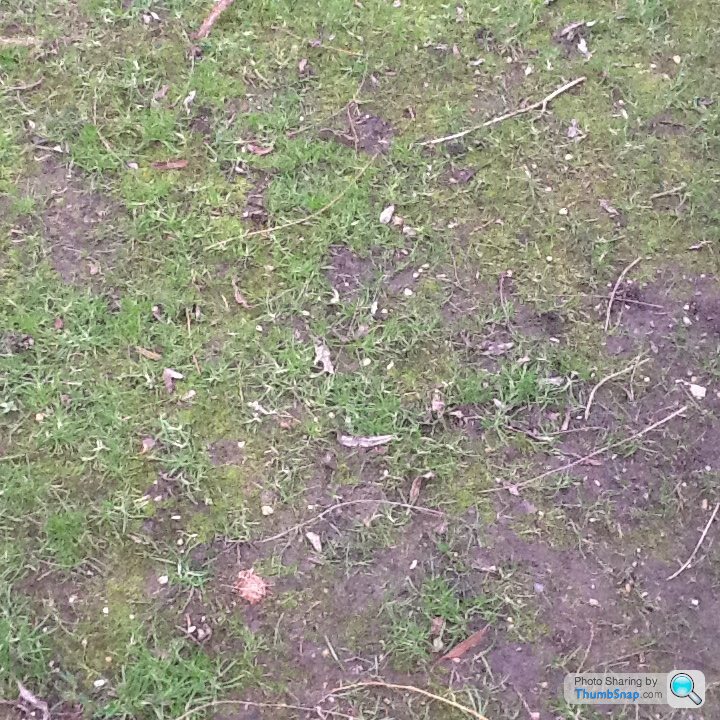
Over seeded last spring and weak spindly growth through the summer. All new growth died off in the autumn.
And this,
I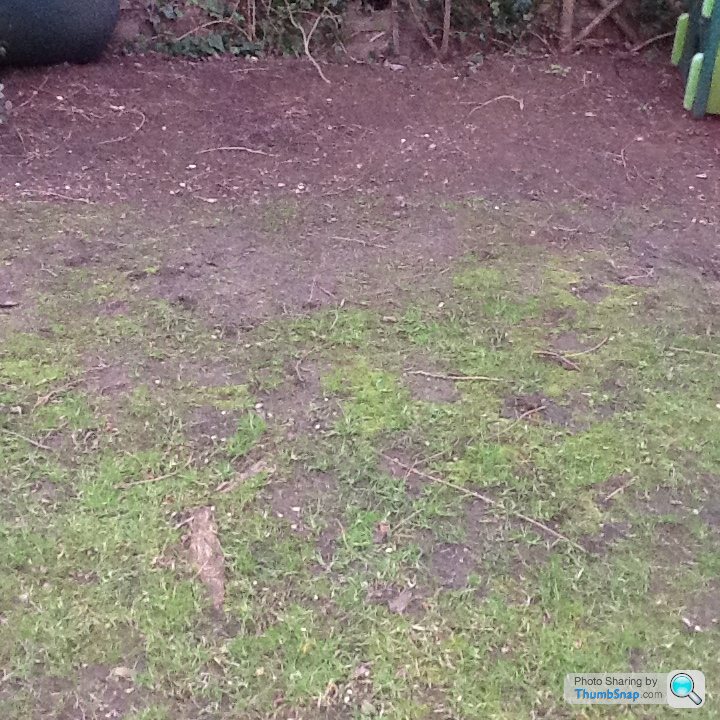 i
i
New turf laid at the same time. Now all dead
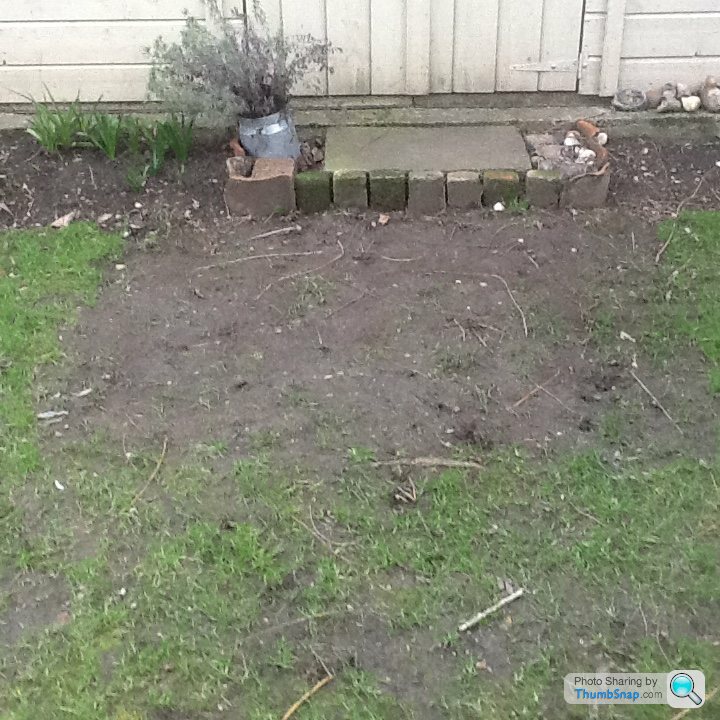 k
k
Same new turf in another area.
[url]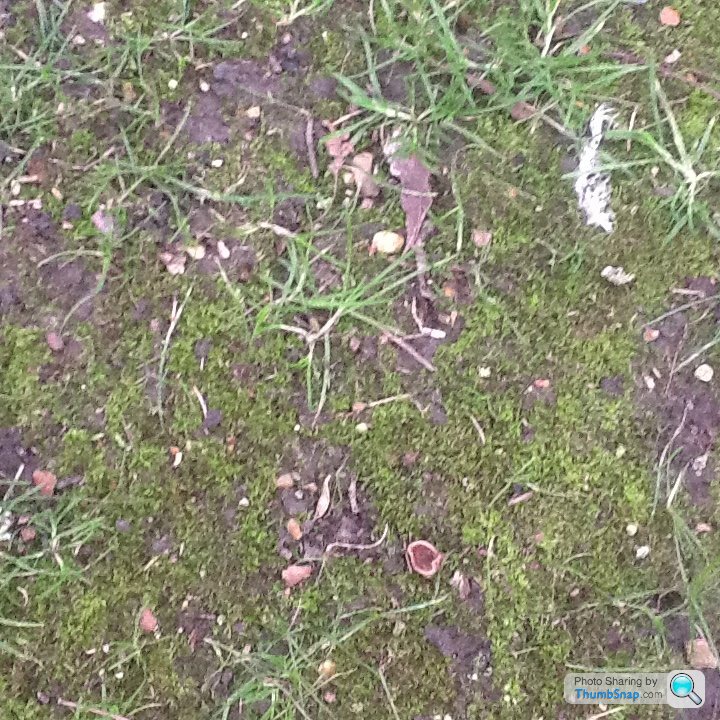
More dead patches
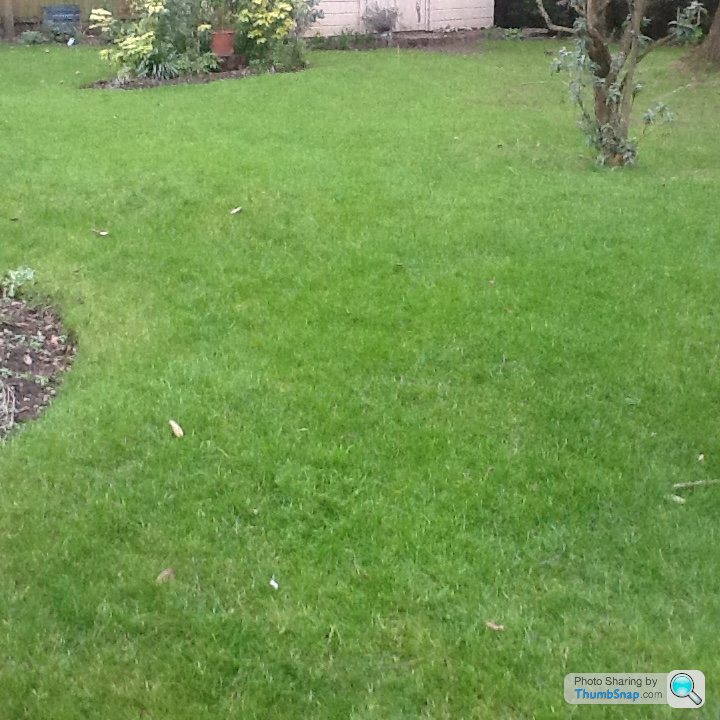
But the rest of the lawn looks like this.
Any ideas what to do? Cheers Chaps.

Over seeded last spring and weak spindly growth through the summer. All new growth died off in the autumn.
And this,
I
 i
iNew turf laid at the same time. Now all dead
 k
kSame new turf in another area.
[url]

More dead patches

But the rest of the lawn looks like this.
Any ideas what to do? Cheers Chaps.
Edited by Jaguar steve on Friday 12th February 16:32
Jaguar steve said:
Any help or suggestions with this?

Over seeded last spring and weak spindly growth through the summer. All new growth died off in the autumn.
And this,

The second photo looks as though that area gets a lot of shade? Also there's tree roots visible in the lawn area competing with the grass.
Over seeded last spring and weak spindly growth through the summer. All new growth died off in the autumn.
And this,

Either dig down and get rid of some of the roots, or build up the soil level for a deeper turf rootzone. Then seed with a shade tolerant variety and be aware that it'll need more watering in the summer than the rest of the lawn.
Jaguar steve said:
Suffering from shade, plus traffic to the shed? Possibly compaction of the soil from historic shed traffic if you didn't dig it over before laying the turf.I'd put some pavers down close to the shed door, decompact the surrounding ground and sow some wear tolerant seed. Then try to take varying routes to the shed door to avoid a single well worn path.
In both cases regular overseeding will likely be necessary as they're tough environments for even the best suited grasses.
My 'lawn' is heavy clay, and mostly not grass.
It doesn't seem to get boggy at all thankfully, but its certainly slippery when wet, and goes rock hard over the drier months, sometimes massive cracks open up in it. Its quite uneven underfoot.
Weeds are prolific, but the grass does seem to grow like mad.
What would your plan be? I have kids and dogs, so a complete start-again is out of the question. My lawn regime to date has been mow most weeks from March to December ish, thats about it.
Thanks in advance!
It doesn't seem to get boggy at all thankfully, but its certainly slippery when wet, and goes rock hard over the drier months, sometimes massive cracks open up in it. Its quite uneven underfoot.
Weeds are prolific, but the grass does seem to grow like mad.
What would your plan be? I have kids and dogs, so a complete start-again is out of the question. My lawn regime to date has been mow most weeks from March to December ish, thats about it.
Thanks in advance!
Jaguar steve said:
To much shade then? Most of the affected area is under a large willow tree and I hadn't realized 'till now that could be the problem. More soil and shady lawn grass seed this spring? If so which seed mix is best?
Cheers Chaps
Willows are particularly thirsty trees as well, so you'll need to keep on top of watering that area in the summer. Two possible seed mixtures that should suit are Lawnsmith's Staygreen dwarf ryegrass / tall fescue mix, or DLF's Masterline PM60 Greenshade fescue / rough stalked meadow grass blend. Both will give you a really nice looking turf, be shade and drought tolerant and cope well with general lawn traffic.Cheers Chaps

essayer said:
Ah, the perfect thread.
I have just bought a house fitted with one of these 'lawns' and will be moving in shortly.
What weekend jobs do I need to spend my whole year doing? My track record with plants is not good so keep it simples please.
Keep the lawn cut each week when it's growing. Make sure that your mower's blades are nice and sharp. Avoid removing more than a third of the grass's height in one go. The shorter you keep it the more often you'll have to mow to keep within the one third rule. Give it a feed in the spring and the autumn with a slow release fertiliser and spot spray or dig out weeds as they appear. Any thin patches can be oversown with fresh seed. Usually that's all you need do to have a lawn that you can be proud of and one that's in far better condition than most if not all of your neighbours' lawns.I have just bought a house fitted with one of these 'lawns' and will be moving in shortly.
What weekend jobs do I need to spend my whole year doing? My track record with plants is not good so keep it simples please.

BigTom85 said:
My 'lawn' is heavy clay, and mostly not grass.
It doesn't seem to get boggy at all thankfully, but its certainly slippery when wet, and goes rock hard over the drier months, sometimes massive cracks open up in it. Its quite uneven underfoot.
Weeds are prolific, but the grass does seem to grow like mad.
What would your plan be? I have kids and dogs, so a complete start-again is out of the question. My lawn regime to date has been mow most weeks from March to December ish, thats about it.
Thanks in advance!
The soil is likely to be very compacted from being walked on when wet. Clay soils suffer more than sandy soils from this. I'd aerate it in the spring either with a garden fork or hire in a hollow tine aerator. Top dressing afterwards with a top soil / compost mix will help. In clay soils, good quality compost will improve structure, reduce surface crusting and compaction, promote drainage, and provide nutrients. Overseeding with a grass mix such as Lawnsmith's Easygreen will help fill in the bare patches.It doesn't seem to get boggy at all thankfully, but its certainly slippery when wet, and goes rock hard over the drier months, sometimes massive cracks open up in it. Its quite uneven underfoot.
Weeds are prolific, but the grass does seem to grow like mad.
What would your plan be? I have kids and dogs, so a complete start-again is out of the question. My lawn regime to date has been mow most weeks from March to December ish, thats about it.
Thanks in advance!
In the summer water it well if it looks to be drying out to avoid it becoming rock hard. Once it gets to that stage it takes much longer for subsequent rain to soak in.
Avoid trying to add sand to the soil to improve drainage unless you plan on adding a lot as it can often make the situation worse if you don't add enough.
On the plus side, clay soils retain nutrients much better than sandy soils and don't need watering so often.
Whilst we're on it, can anyone recommend a hollow tine aerator for DIY use? Is this any good?
http://www.ebay.co.uk/itm/Handy-Hollow-Tine-Lawn-A...
http://www.ebay.co.uk/itm/Handy-Hollow-Tine-Lawn-A...
Tbh I wouldn't bother with one that collects the cores like that. The hopper is so small it's not going to save time. If you want one similar, but simpler and cheaper I'd just get the one from Lawnsmith here.
With those types I find that using an angle grinder to cut the ends at a steeper angle helps a lot, as well as occasionally sharpening them after being used for a while is also useful. If you don't then it's much harder to push them through the turf and the tines block up more easily.
With those types I find that using an angle grinder to cut the ends at a steeper angle helps a lot, as well as occasionally sharpening them after being used for a while is also useful. If you don't then it's much harder to push them through the turf and the tines block up more easily.
Gassing Station | Homes, Gardens and DIY | Top of Page | What's New | My Stuff



